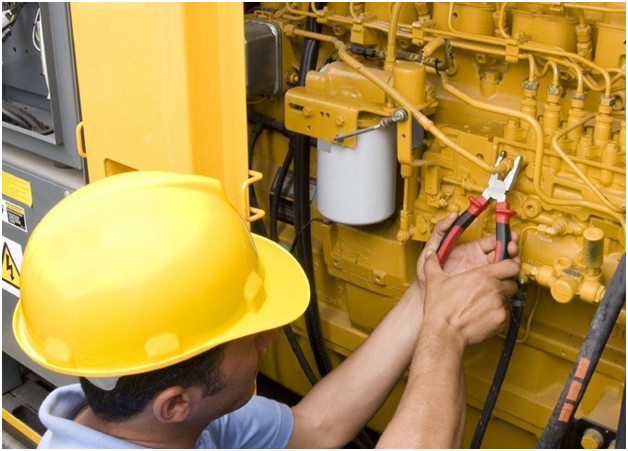Imagine if you fell asleep for a few months, and when you woke up, you needed to be caught up to speed about what had happened while you were asleep. The same thing happens to generators! If generators are powered down and connected during different times or at different workloads for events like maintenance or power outages, it is important that they are synchronized.
Generator synchronization is the exercise of catching a generator back up to speed by matching its variables, such as voltage, phase sequence, phase angle, and frequency to another generator or source with a healthy, current (actively running) power system. This must be completed before the generator is connected back to the system. Once the generator has been successfully synchronized and is up to speed with the other generator or power system, the generator can once again be of use.
Generator synchronization is a delicate process, and it must be done mindfully in order to mitigate any damage that may occur to the power system and the generator. The voltage and frequency must match very closely, if not exact. Additionally, the instantaneous power system phase angle and the rotor angle need to be very similar, before closing the breaker and connecting the generator being synchronized to the power system. Typically, generator synchronization is automated, using an automatic synchronizer (these often have manual controls that can be used, too). The automatic synchronizer will have information that tells you if there are any issues that need to be addressed, and when the breaker can be closed and the generator is ready.
Why do I need to synchronize my generator?
In many power plants or businesses, instead of using one large generator, many smaller generators are used to supply power. This is referred to as the parallel operation of generators. Multiple smaller generators are typically more reliable than one large generator, because if one generator is damaged or needs to be repaired, the others remain active, meaning the entire power system will not be shut down. In the modern world, the need for power is always increasing, so companies are constantly adding to and modifying generators. This is why generator synchronization is so important.
Without generator synchronization, generators cannot bring power to a system, unless all of the variables match the power network. This is especially important when multiple generators are attached to a system, as electrical loads fluctuate constantly. Without synchronization, the generators working together cannot supply the needed amount of power in order to operate in parallel, which can lead to low productivity.
A poorly done synchronization can damage the power system, resulting in electrical and mechanical variations that can damage the system, generators, or equipment connected.
Synchronization Techniques
Generator synchronization may seem like a difficult subject to tackle, but there are different methods that can be used. Here are a few.
Three Dark Lamps Method
Three lamps are connected across the switches of the generator. When all of the parameters are satisfied, the lamps should remain dark. However, this is a relatively rudimentary method, as it cannot give you any information on the frequency of the generator or the bus bar.
Two Bright, One Dark Method
Again, three lamps are connected to the system. When two remain lit and one is dark, the parameters for the system have been met. This easily measures the frequency of the generator and bus bar, but you cannot be sure of how correct the phase sequence is.
Synchroscope Method
In this method, as you may have guessed, a synchroscope is used to test whether the frequency of the alternator is higher or lower than that of the bus bar.
Using modern, automatic synchronization equipment is the most effective, as you do not need to employ the use of lamps or synchroscopes. Due to this, it is typically much more effective with little room for mistakes.
Generator Synchronization Gone Wrong
Since generator synchronization is such a delicate affair, without the use of automatic synchronization equipment, it can lead to mistakes and potential for danger. For example, if rotating masses are accelerated or decelerated too quickly, the generator and prime mover can become damaged. The generator and step-up transformer windows can sustain damage due to high currents. The power system can also be interrupted, due to voltages that do not match between generators. Lastly, if synchronization is done incorrectly, the generator may not stay on the system, placing the load heavily on another alternator, causing generators to shut off, creating damage to the system or the equipment.
Overview
Generator synchronization is no laughing matter and needs to be conducted accordingly. Without proper synchronization, your system will not be running at full power and you run the risk of ruining your machines. If you have any questions about synchronization of your used generators, contact us at Swift Equipment Solutions via phone +1-866-571-0044 or send us an e-mail at sales@swiftequipment.com today!
Frequently Asked Questions (FAQ)
Why do I need to synchronize my generator?
If you have multiple generators, it is important to synchronize in order to ensure that your system is productive. Without proper synchronization, damage can occur in the generators, the system, or the connected equipment.
What is the best way to synchronize my generator?
While there are many methods, the most effective way is to employ the use of an automatic synchronizer. These provide the most reliable way to ensure your machine is synchronized.
When should I synchronize my generator?
If your generator has been taken off the power system for any reason, such as repairs, maintenance, or has simply been shut off, it is important to synchronize it to the system in order to keep it (and your system) in good working order.







Leave A Comment